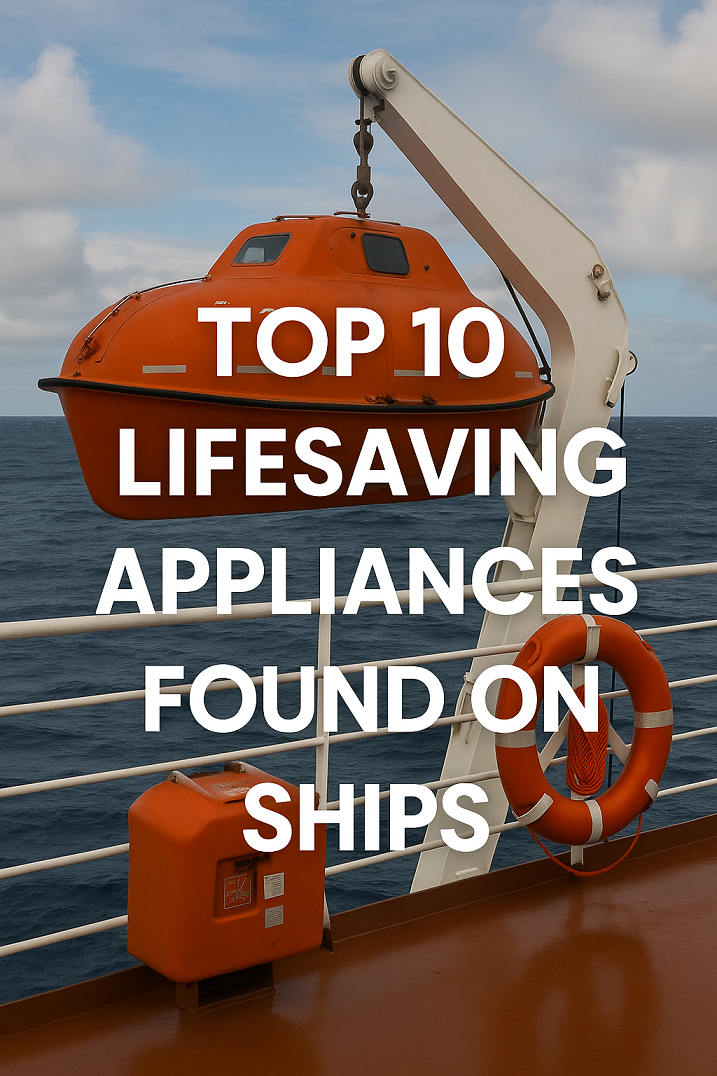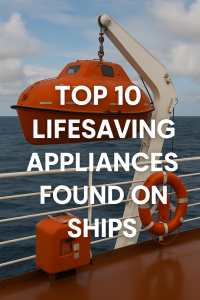Discover the top 10 lifesaving appliances found on ships and how they safeguard lives at sea. Learn their functions, compliance standards, and practical use in maritime emergencies.
Why Lifesaving Appliances Matter in Modern Maritime Operations
In the unforgiving environment of the open sea, even the most advanced navigation and engineering systems can fail. When that happens, lifesaving appliances (LSAs) become a vessel’s last line of defense against disaster. These critical systems are more than regulatory requirements—they are essential to survival. Mandated by the International Convention for the Safety of Life at Sea (SOLAS), lifesaving appliances are designed to protect, sustain, and facilitate the rescue of crew and passengers during maritime emergencies. Whether it’s a fire, flooding, grounding, or collision, LSAs can mean the difference between life and death.
This guide breaks down the top 10 lifesaving appliances found on ships, offering insight into their design, operational requirements, and real-world applications. Every seafarer—from cadet to captain—should understand these devices and how to use them effectively.
Understanding Lifesaving Appliances: The SOLAS Framework
LSAs are covered under SOLAS Chapter III and further detailed in the LSA Code (International Life-Saving Appliance Code), which outlines the performance standards and testing requirements for every type of life-saving equipment carried on board.
Regulations also intersect with:
-
STCW Code for crew training
-
ISM Code for safety management
-
IMO resolutions for updates on design and carriage standards
1. Lifeboats
Lifeboats are the most recognized lifesaving appliances and serve as the primary means of abandoning a vessel.
Types Include:
-
Totally enclosed lifeboats
-
Free-fall lifeboats
-
Open lifeboats (rare on modern SOLAS ships)
Each SOLAS-compliant lifeboat must:
-
Carry survival provisions (water, food, signaling gear)
-
Have an engine for maneuvering
-
Be launched within 10 minutes with a trained crew
Real-World Case: During the Costa Concordia disaster (2012), the partial success in lifeboat launching played a critical role in reducing fatalities despite the chaotic evacuation.
2. Life Rafts
Unlike lifeboats, life rafts are inflatable and automatically deployable in some designs. They act as secondary survival units.
Requirements:
-
Must inflate within 1 minute
-
Carry survival packs (A or B depending on operational area)
-
Equipped with canopies and thermal insulation
-
Minimum 125% capacity compared to total persons onboard (combined lifeboats and rafts)
Deployment: Automatically released via a hydrostatic release unit (HRU) or manually using painter lines.
3. Life Jackets
Life jackets are designed to keep an unconscious person’s head above water and must be accessible for all persons on board, including child-sized variants.
SOLAS Standards:
-
High-visibility material
-
Whistle and retroreflective tape
-
150N buoyancy for adults
-
Compatibility with immersion suits
Modern life jackets are often integrated with locator beacons for enhanced search and rescue support.
4. Immersion Suits
Also known as survival suits, these provide thermal insulation and buoyancy in cold water.
Features:
-
Waterproof, flame-resistant outer layer
-
Head covering and sealable zippers
-
Must be donned within 2 minutes without assistance
Use Case: Required in areas where water temperature is below 15°C. Vessels operating in Arctic and North Atlantic routes carry suits for all crew.
5. Rescue Boats
Rescue boats are smaller than lifeboats but critical for retrieving persons from the water and assisting during abandon ship scenarios.
Characteristics:
-
Speed and maneuverability
-
Self-righting ability
-
Launchable within 5 minutes
IMO Mandate: Ships with free-fall lifeboats must carry a separate rescue boat. It can be rigid-hull or inflatable.
6. Life Buoys
Also called life rings, these are throwable flotation devices positioned around the ship’s perimeter.
SOLAS Specs:
-
Fitted with grab lines
-
Equipped with self-activating light and smoke signals
-
At least one buoy must include a lifeline (30m)
Minimum Carriage: Varies by ship size but typically 8 to 12 life buoys on merchant vessels.
7. Emergency Position-Indicating Radio Beacons (EPIRBs)
EPIRBs automatically transmit distress signals via satellite to alert Maritime Rescue Coordination Centers (MRCCs).
Features:
-
Float-free mechanism
-
406 MHz transmission (COSPAS-SARSAT system)
-
Operates for 48 hours minimum
Stat: According to the IMO, over 85% of maritime search and rescue operations since 2010 were aided by EPIRB activation.
8. Search and Rescue Transponders (SARTs)
SARTs assist rescuers by producing radar echoes visible on X-band radar screens.
Functions:
-
Activates when radar beam contacts the unit
-
Displays a dotted line to rescuers
-
Operates at ranges up to 12 nautical miles
Carriage Requirements: At least 1–2 SARTs are required on SOLAS ships, typically stowed in survival craft or bridge.
9. Distress Signaling Equipment
Ships must carry visual and auditory distress signals for use in emergencies.
Included Items:
-
Parachute flares (minimum of 12)
-
Smoke signals (2 orange smoke for each lifeboat/raft)
-
Hand flares (6 per craft)
Training Importance: Crew should know how to use and identify expiration dates to avoid PSC detentions.
10. Emergency Escape Breathing Devices (EEBDs)
EEBDs provide short-duration breathable air (at least 10 minutes) for escape from smoke-filled or toxic environments.
Common Locations:
-
Engine room
-
Accommodation corridors
-
Enclosed spaces
Note: EEBDs are not used for firefighting or rescue—they are strictly escape devices.
Case Study: Lessons from the Norman Atlantic Fire (2014)
In a fire aboard the Norman Atlantic ferry, improper use and inaccessibility of life-saving appliances led to unnecessary fatalities. Investigations revealed life rafts were inadequately secured, and muster drills had not been properly conducted. The tragedy underscored that LSA training is as vital as the equipment itself.
FAQ: Lifesaving Appliances on Ships
Q1: Are lifeboats and life rafts mandatory on all ships?
A: Yes, as per SOLAS Chapter III. The total survival craft capacity must exceed the number of persons onboard.
Q2: How often must LSAs be inspected?
A: Weekly, monthly, and annually. Some equipment, like EPIRBs, requires shore-based servicing every 5 years.
Q3: What is the difference between a SART and an EPIRB?
A: EPIRBs send signals via satellite; SARTs work by reflecting radar signals for local detection.
Q4: Do all crew need immersion suits?
A: Only if operating in waters below 15°C, per SOLAS regulation III/32.3.
Q5: What is the minimum number of flares required on board?
A: At least 12 rocket parachute flares and 6 hand flares in total, plus equipment in each lifeboat and life raft.
Conclusion
Lifesaving appliances are the silent guardians aboard every vessel—rarely used but always ready. Knowing their function, maintenance requirements, and proper use is not only a matter of compliance—it’s an ethical obligation for every seafarer.
The best LSAs are only as good as the crew trained to use them. In a real emergency, there’s no time to read the manual.
Call to Action: For detailed checklists, SOLAS updates, and LSA training modules, visit our Ship Safety Resource Hub.
References
-
International Maritime Organization. (2020). LSA Code and SOLAS Chapter III. https://www.imo.org
-
Paris MoU. (2023). Port State Control Inspection Statistics. https://www.parismou.org
-
European Maritime Safety Agency. (2022). Maritime Accident Review. https://emsa.europa.eu
-
United States Coast Guard. (2021). Survival Craft Requirements Overview. https://www.uscg.mil


